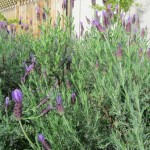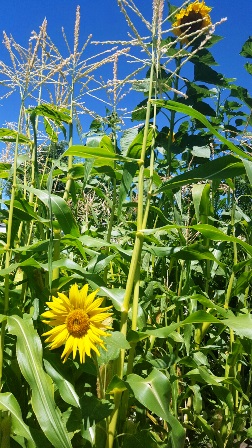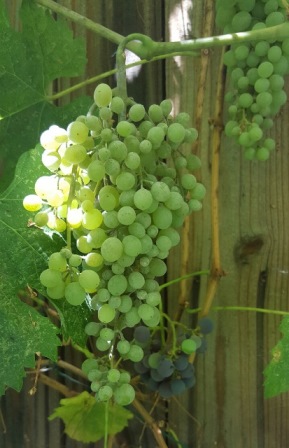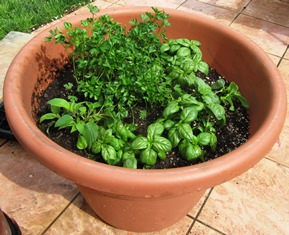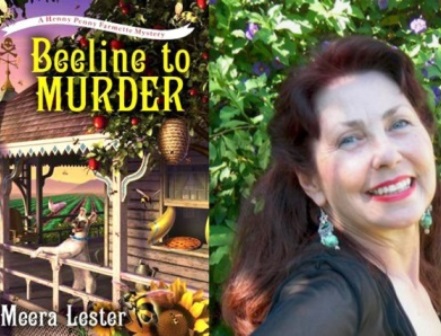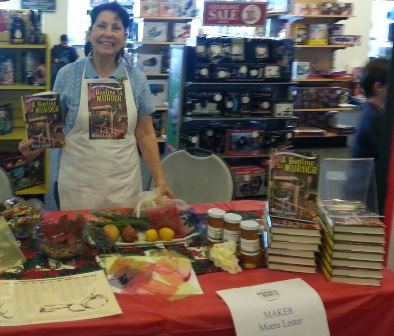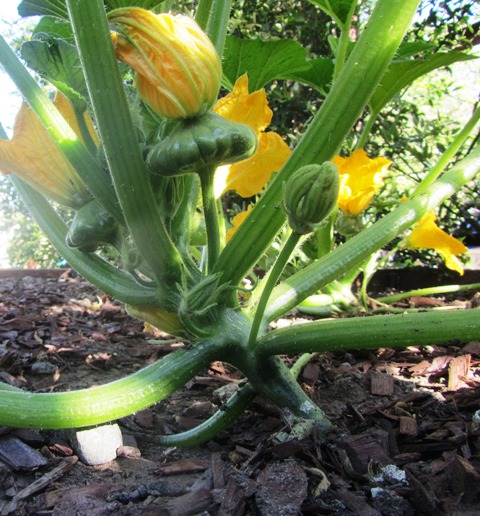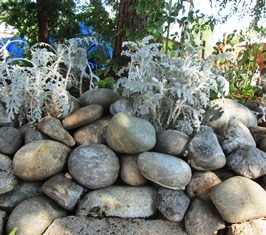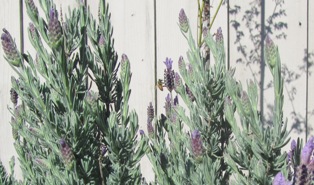Backyard Herbal–Hair Rinses and Hot Oil Treatments
In college, I often washed my then waist-long auburn hair with apple cider vinegar to keep the locks healthy and shining. And years ago, I discovered the decadent pleasure of a hot rosemary oil treatment and scalp massage that uses lavender oil.
If you grow your own herbs, making hair-care products couldn’t be easier.
The following are simple recipes you can make with home grown herbs and essential oils available in health food stores.
Apple Cider Vinegar Rinse Recipe: 4 cups of warm water to 1 cup apple cider vinegar. After you’ve washed the shampoo out of your hair, use the vinegar water as your final rinse.
Alternatively, you could add a couple of ounces of your favorite herbs like lavender, lemon balm, chamomile, or rosemary sprigs along with scented essential oils to impart shine and fragrance to your hair. Rosemary is also good for promoting hair and scalp health.
Rosemary Rinse Recipe: 4 cups of boiling water poured over 2 ounces of rosemary springs. Let set overnight under a lid or cover. The next day, strain out the rosemary sprigs and add to the liquid 10.5 ounces of apple cider vinegar and 10 drops of rosemary essential oil. Wash your hair, rinse, and as a final step pour through your hair the rosemary rinse.
For dry hair and scalp, create an oil treatment that you can do once every three weeks or a on a monthly basis. You’ll need rosemary, lavender, and a bit of tea tree oil (which possesses chemicals that may kill bacteria and fungus and reduce dandruff).
Hot Herbal Oil Treatment: 2 drops each of the following herbal oils–rosemary, tea tree, lavender–in 6 tablespoons of coconut oil. Thoroughly combine in a dark bottle, seal, and store. When you are ready for your hot oil treatment, sparingly apply the oil to strands of dry hair until all is lightly coated, not saturated. Cover with a hot towel for 15 to 20 minutes. Remove the towel and wash with shampoo as usual.
________________________________________________________
If you love all things natural, country, and homemade AND you enjoy a cozy mystery, check out my novels available online at Amazon.com, Barnes & Noble, Walmart, and other retail outlets as well as in bookstores everywhere.
For my newest novel, A HIVE OF HOMICIDES, click on the link: http://tinyurl.com/ya5vhhpm
What’s Growing in the July Garden?
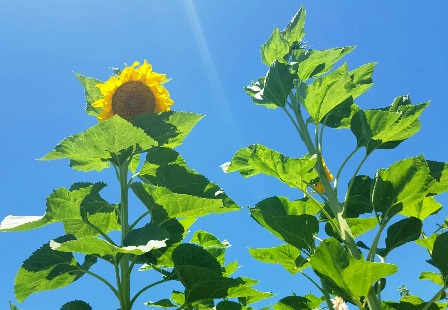
Sunflowers are native to North America and were taken to Europe in the 16th century; however, they date back to roughly 3,000 B.C. Honeybees love sunflowers.
Towering above the squash and lavender in my garden are rows of green corn stalks bearing ears of sweet, plump kernels. Snaking along the rows at the base of the cornstalks are vines laden with butternut squash and Armenian cucumber.
There are ripe tomatoes, too, especially the prolific heirloom–Red Beefsteak. I love cutting up some of these fresh, thin-skin tomatoes and combining them with basil, olive oil, grated cheese, and pine nuts as a topping for pasta. Add some grilled, seasoned chicken and you’ve got a quick and delicious summer lunch.
Zucchini and yellow squash sport large, showy blooms and are producing like crazy this month. While you can harvest and eat the blooms, we prefer the squash. Zucchini is delicious grilled or tossed with rosemary potatoes and onions or made into a French lentil and tomato salad (see recipe from last week’s posting).
Growing on vines trained over a wall and on supports, the green table grapes are beginning to swell. The taste is still a little tart, but will sweeten with the passage of another couple of weeks.
* * *
If you enjoy reading about farmette topics (including gardening, beekeeping, and delicious recipes), check out my cozy mysteries A BEELINE TO MURDER and also THE MURDER OF A QUEEN BEE in the Henny Penny Farmette series (from Kensington Publishing).
These novels are available through online retailers such as Amazon, Barnes & Noble, Kobo Books, and Walmart as well as from traditional bookstores everywhere.
Now available in mass market paperback, this debut novel launched the Henny Penny Farmette series of mysteries and sold out its first press run.
COMING SOON: The second cozy mystery in the Henny Penny Farmette series, available Sept. 29, 2016
Uses of Herbs in Your House and Garden
Herbs in abundance line the shelves of local garden centers now, and for good reason. Many of these versatile plants are hardy and adaptable and have myriad uses in a landscape.
Cooks, especially, appreciate access to culinary herbs near the kitchen. Grow cilantro, parsley, sage, tarragon, chives, basil, anise, dill, mint, and other desirable culinary herbs in boxes or giant pots on a kitchen patio. The location will make it easy to water and gather them.
Many herbs like chives, sage, and dill re-seed themselves, therefore, consider growing these in containers unless you have a designated space in your garden for them.
For shady areas in a landscape or garden, plant sweet woodruff, Borage, and chamomile. In areas that receive full sun, plant rosemary, mother-of-thyme, caraway-scented thyme, and woolly thyme. In areas that remain moist, plant angelica, mints, parsley, and sweet woodruff.
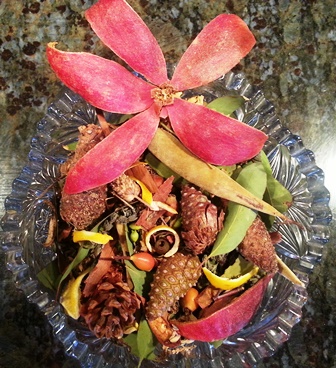
The leathery pomegranate peel takes center stage in this potpourri that utilizes herbs, seed pods, spices, and citrus peels
To grow herbs for potpourris and sachets to scent rooms in your home, cultivate costmary, English woodruff, and lemon-scented herbs like pelargonium and verbena. Also rose geranium and lavender add a lovely scent to mixtures of herbs for potpourri.
With so many different ways to use herbs to beautify a garden or patio and to flavor foods and scent a home, there’s no reason not to grow a few. Remember, herbs (like mint) can be dried for tea or crumbling over salads and you can collect herb seeds or propagate cuttings for next year’s herb garden.
Fern-leaf Lavender Is Easy to Grow and Re-seeds
My hubby brought home several Lavandula multifida plants in five-gallon pots. Also known as Egyptian lavender or Fern-leaf lavender, the plant’s foliage appears fernlike, hence its common name.
The Fern-leaf lavender carries its bluish-purple bloom on three- to five-inch spikes. It’s a pretty plant in the garden, however, its scent is not of lavender as one might expect but rather more like oregano. The foliage is more pungently scented than the buds.
This evergreen perennial is classified as a sub-shrub. In cold climates, the frost kills it. However, it can be grown as an annual. In California and Arizona, the plant blooms from spring through late summer into fall. The blooms are tri-pronged.
These plants reach a height of about 24 inches. They are among the 39 species of lavender that belong to the genus Lavandula in the family of Labiatae (a family which also includes mint, rosemary, thyme, sage, savory, and basil).
The Fern-leaf lavender (like other species of Lavandula) attracts bees, butterflies, and other pollinators. It’s a lovely plant that will provide spectacular color in any garden or around a pool.
For more gardening tips, delicious recipes, farm sayings, and a fun mystery, check out my Henny Penny Farmette series of cozy mysteries, including A BEELINE TO MURDER, and THE MURDER OF A QUEEN BEE.
My books are available on Amazon, Barnesandnoble.com, and other online and traditional bookstores. See, http://www.amazon.com/Beeline-Murder-Henny-Farmette-Mystery/dp/161773909X/ref=sr_1_3?s=books&ie=UTF8&qid=1458077651&sr=1-3&keywords=Meera+Lester
Heirloom Herbs for the Kitchen
The green stalks of the red and yellow onions I planted in late summer are now up about a foot in a raised bed. The garlic that I planted around the same time is also poking up. Having onions, garlic, and fresh culinary herbs available year-round is not impossible in the Bay Area’s mild climate, especially when they are grown in cold frames, protected areas, and raised beds.
Some will re-seed themselves in the growing beds or around your yards. We’ve got Greek oregano and chives growing all over the place. Some of my favorites herbs include basil, cilantro, chervil, chives, dill, fennel, lemon balm, lavender, oregano, mint, marjoram, rosemary, thyme, parsley, sage, and savory.
We also grow a few ornamental herbs such as borage, hyssop, and catnip (for our new kitty), tea herbs (chamomile and mint), and medicinal herbs (like echinacea).
Herbs are easy to grow. Their blooms will attract insects beneficial to the garden. Butterflies and hummingbirds are also attracted. And herbs don’t need much–light, and porous soil, warmth, and decent drainage. For a light feeding of the herbs, we make chicken poop tea. With so many varieties of herbs available, why not tuck a few in your garden or in containers in a protected but sunny and warm area of your patio to enjoy in your culinary creations?
Easy Peasy Holiday Potpourri
Potpourri mixtures are easy to create and their long-lasting fragrance can add an attractive visual appeal and fresh scent to any room. You can find many items in nature. Use a festive basket or crystal bowl for displaying your potpourri.
Go on a nature walk to hunt for materials (see the List of Potpourri Items below).
Visit a shop for spices–whole nutmeg, cinnamon sticks, cloves, and allspice.
Cut or purchase herbs (preferably dried)–lavender, rosemary, and mint.
Combine nature’s materials with spices, dried herbs, and dried citrus slices and peels.
Add rose petals, lavender buds, and/or pinecones and red cedar bark.
Arrange pretty seashells or small pieces of driftwood.
Include fresh leaves and berries from eucalyptus trees and also he fuzzy seed pods of wisteria.
Put the potpourri in a pretty basket or cut crystal bowl; add a drop or two of essential oil if desired.
LIST OF POTPOURRI ITEMS
Combine using any of the following to create interesting mixes, textures, and colors.
- pinecones
- eucalyptus leaves and berries
- rose hips
- citrus peels
- pomegranate peel
- lavender buds
- rosemary
- yarrow
- seed pods
- red cedar bark
- cinnamon sticks
- dried rose petals
- citrus slices
- allspice
- peppercorns
- dried nutmeg
- dried apple slices
- carnation petals
- seashells
- dried rose petals
- dried mint
- essential oil—(rose, lemon, lavender, vanilla) to intensify scent
Find other ideas for farm crafts and delicious recipes in A BEELINE TO MURDER.
Click here: http://tinyurl.com/nhdae39
Re-Cap of the Mini-Maker Faire at Barnes & Noble
My fingers still smell like French perfume lavender and rosemary from all the organza sachet bags I helped customers fill as a giveaway during the three day Mini-maker event this past weekend. Hosted by the Walnut Creek Barnes & Noble Bookstore, the event was a huge success for the store, the customers, and participating authors.
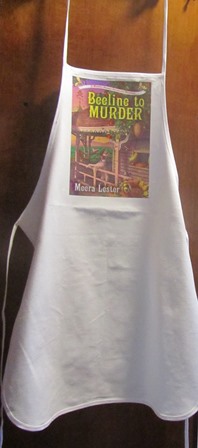
I wore an apron bearing the image of my book cover while I helped stuff bags with lavender and rosemary
All the signed copies of A BEELINE TO MURDER sold out and only a few unsigned copies are left. I gave away close to 100 organza bags and special embroidered bags I made for the event. Thank you citizens of the East Bay!
I met a lovely eleven-year-old boy who wrote novels. We exchanged email addresses and he’s already sent me his first two. I’ve promised to read and send him comments. All the while he was talking to me, I kept thinking “boy, did I get a late start writing.”
Another lovely customer bought the book for her mother back in North Carolina because winters on the other coast can be harsh, and a lover of mysteries can’t have too many on hand when the storms hit.
The mother of a Girl Scout invited me to do a presentation before their troop in early spring. I love the organization and will give it my best shot at the end of February or early March. It’ll be a chance to talk to the girls about writing books as a career, making things from nature, and having the courage to follow your heart (as I did when I established my farmette).
I enjoyed explaining to a darling Asian girl, while her parents looked on, the differences between wasps and honeybees. It was a great point of departure into a long conversation. We all became fast friends. She danced away holding her little bag of herbs beneath her nose.
In all, I had a great time. I think the store was pleased with all the “makers” who participated. And I’d do it again.
A BEELINE TO MURDER is available through your local Barnes & Noble stores as well as online at BarnesandNoble.com. Books make wonderful holiday gifts and foster the pleasure of reading.
From Garden to Table, Easy-to-Grow Squash
I love summer squash, tossed into rosemary potatoes and served up with eggs and sausage on a Sunday morning; or, grilled with fish, or added to a freshly-made pasta sauce. Best of all, you can have it fresh, from your kitchen garden to your table, as squash is one of the easiest vegetables to grow. Squash is a super food, high in antioxidants, fiber, and Vitamin A.
Squash is one of the Three Sisters (corn and climbing beans being the other two), grown together as companion plants in the tradition of certain groups of Native Americans who planted these vegetables. A fourth sister might be the Cleome serrulata, the Rocky Mountain bee plant to attract pollinators for the beans and squash.
There is a scientific basis for growing these three together. The squash grows fairly large and spreads out, blocking weeds. The beans provide nitrogen to the soil. The corn shoots up a stalk that provides the support the beans need to climb. The three plants benefit each other.
Each year, I plant both summer squash and winter varieties such as butternut and pumpkin that have hard shells and store longer. All types of squash are easy to grow. They just need sun, water, and room. They aren’t fussy about soil.
Summer squash includes zucchini, yellow squash, and scalloped (or round) squash. Autumn/winter varieties require a longer growing period (up to 120 days) and include butternut, acorn, hubbard, and pumpkin.
Growing Tips:
Choose a well-drained, sunny spot in the garden for your squash.
Plant three seeds to a hill (roughly six inches apart).
When the squash are about a foot tall, thin to the healthiest seedling.
Water two to three times each week.
Harvest summer squash when still young; if left on the vine, the squash becomes tough.
The Bee Garden Favorites
I spent Sunday building a rock circle around the circumference of our towering elm tree. I want to conserve water around the base of the tree and to also grow more plants for my bees to have abundant food.
We had a pile of river rock donated to us, so I thought it might look nice to create a wide circle, maybe three feet high around the tree like a watering basin/retaining wall, using the rock.
Inside the circle, I transplanted some yarrow and white geranium. Already, there are white roses that boom all summer long under the tree.
But bees like nectar-rich plants with pollen, so I’ve put together a list. Over the next week, I’ll add some of these in my new bed beneath the elm. This is a partial list of plants bees love.
- Rosemary
- Lavender
- Russian sage
- Basil (African blue)
- Honeywort
- Mexican Sunflower
- Borage
- Cerinthe
- Greek oregano
- Sweet marjoram
- Purple coneflower (echinacea)
- California poppies
- Lupine
- yarrow
- sunflowers
Eucalyptus on the property behind our farmette is not yet covered with fall bloom. The bees love that bloom but now they make do with the star thistle on the brown hillsides and by foraging on the French perfume lavender and the Spanish variety in my garden.
Of late, I’ve discovered the honeybees foraging on the sweet nectar at my hummingbird feeders, so I worry about them getting enough food. The drought has sapped everything. At any rate, I’ll hold off taking honey this fall, leaving it in the hives for the bees. They’ll need food to get through the rainy season.
Herbs to Flatter Vegetables, Flavor Meat, and Finesse Fertility

If you have limited space, use taller herbs like this lavender in your landscape and gr0w smaller plants like mint in pots
Herb gardens have always held a fascination for me. One of the many reasons I love growing herbs is the scent that many herbs release with bruising that can occur when you brush against plants such as bee balm, rosemary, or lavender.
Most herbs contain fragrant oils (verbena and lavender, for example) that are frequently used in the making of cosmetics. Many herbs reseed themselves, ensuring a perennial supply for medicinal and culinary uses.
For thousands of years, herbs have been added to food to enhance the flavors. In fact, many cuisines of the world are distinctly identifiable from herbs and mixtures of them added to the food. Imagine Italian marinara without the addition of basil in the tomato sauce; a French meat or vegetable dish without savory, fennel, sorrel, rosemary, or tarragon; or an English traditional dish without bay leaf, marjoram, garlic, or mint. Consider Greek food without rosemary, thyme, or arugula.
Herbs have been used to flavor vinegar, olive oil, and liqueur. Herbs even play a role in amorous arousal. In France, Verveine du Velay is a vervain-flavored liquer popular in Le Puy. It’s reputation is further enhanced by the popular ages-old perception of it as an aphrodisiac. According to author Jade Britton (The Herbal Healing Bible, Chartwell Books, Inc.), the herbs Siberian ginseng, damiana, and saw palmetto have been used in remedies to treat male infertility along with gingko for increased blood supply to the male sex organ. See, http://www.amazon.com/The-Herbal-Healing-Bible-Traditional/dp/0785829652
While many herbs thrive in well-drained, sunny positions in the garden, others do equally well in part sun/shade. For shade-tolerant herbs, plant the following.
Chives
Cilantro/Coriander
Garlic
Lovage
Lemon Balm
Mint
Oregano
Parsley
Sweet Woodruff
Thyme
You can grow herbs in a pot, a coffee can, a half wine barrel, window box, even an old wheel barrow. The point is that herbs are not too fussy. Some are so vigorous as to be considered invasive (mint, for example). So whether you seek the enhance the flavor of food, add pizazz to a meat dish, or to increase your stamina, libido, and overall health, maybe it’s time to plant your own herb garden and see what herbs can do for you.
 Facebook
Facebook Goodreads
Goodreads LinkedIn
LinkedIn Meera Lester
Meera Lester Twitter
Twitter




